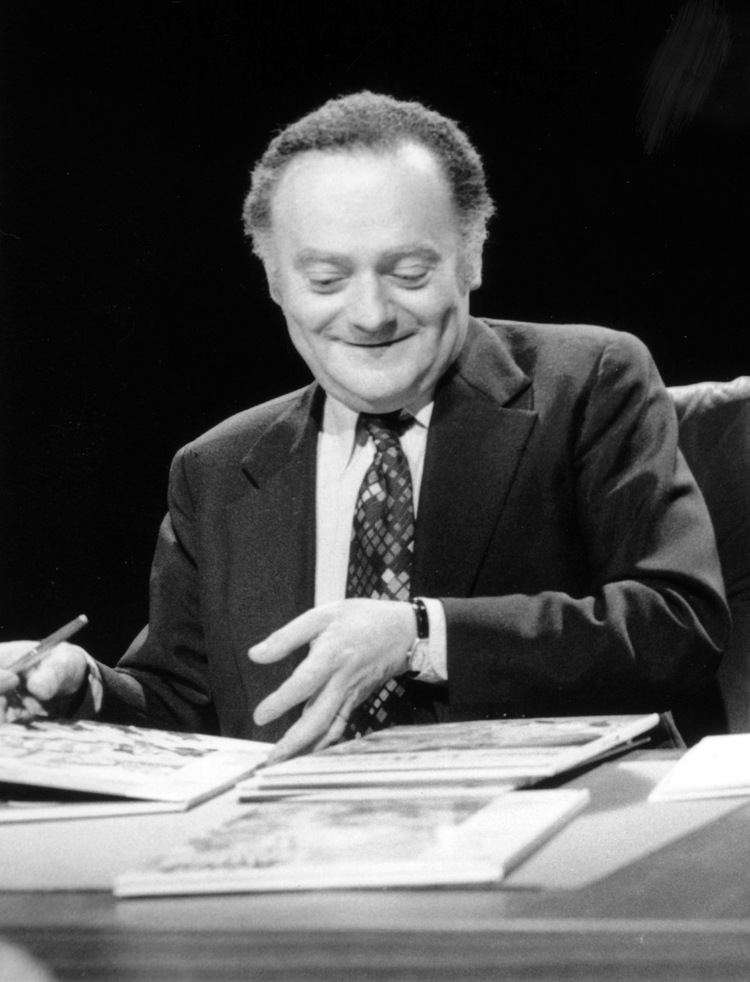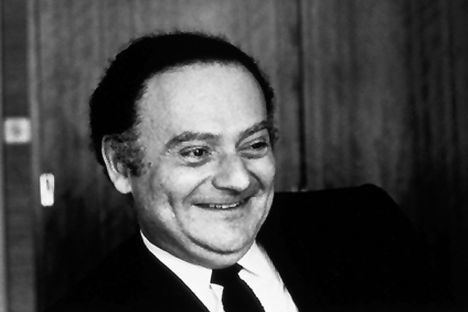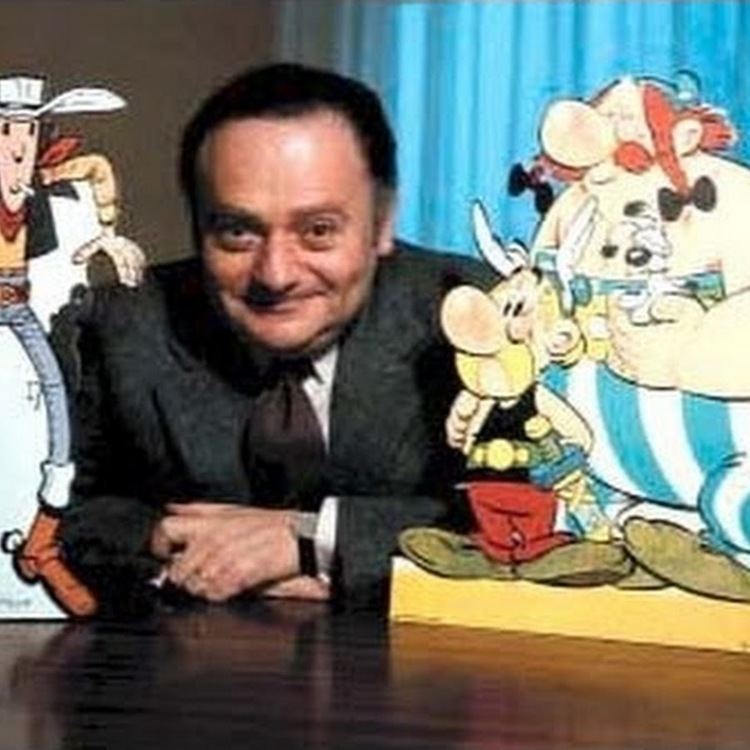Nationality French Role Editor Name Rene Goscinny | Awards full list Children Anne Goscinny | |
 | ||
Born 14 August 1926Paris, France ( 1926-08-14 ) Notable works AsterixIznogoudLe Petit NicolasLucky LukeOumpah-pah Notable collaborations Albert UderzoJean-Jacques SempeMorrisMarcel GotlibJean Tabary Spouse Gilberte Goscinny (m. 1967–1977) Movies Asterix & Obelix Take On Caesar, Little Nicholas Books Asterix the Gaul, Asterix the Gladiator, Asterix and the Golden Sickle, Asterix and the Goths, Asterix the Legionary Similar People | ||
Pseudonym(s) d\'Agostini, Stanislas | ||
Ren goscinny le p re d ast rix l imagination d brid e
René Goscinny ([ʁəne ɡosini]; 14 August 1926 – 5 November 1977) was a French comics editor and writer, who is best known internationally for the comic book Astérix, which he created with illustrator Albert Uderzo, and for his work on the comic series Lucky Luke with Morris (considered the series' golden age) and Iznogoud with Jean Tabary.
Contents
- Ren goscinny le p re d ast rix l imagination d brid e
- Lunivers dlirant de Ren Goscinny Archive INA
- Early life
- First works
- Pilote and Astrix
- Family
- Death
- Awards
- References

L'univers délirant de René Goscinny | Archive INA
Early life

Goscinny was born in Paris in 1926, to a family of Jewish immigrants from Poland. His parents were Stanisław Simkha Gościnny (the surname means hospitable in Polish; Simkha is his Jewish name meaning happiness), a chemical engineer from Warsaw, Poland, and Anna (Hanna) Bereśniak-Gościnna from Chodorków, a small village near Żytomierz in the Second Polish Republic (now part of Ukraine). Claude, René's older brother was born six years earlier, on 10 December 1920. Stanisław and Anna had met in Paris and married in 1919. The Gościnnys moved to Buenos Aires, Argentina, two years after René's birth, because of a chemical engineer post Stanisław had obtained there. He spent a happy childhood in Buenos Aires, and studied in the French schools there. He had a habit of being the "class clown", probably to compensate for a natural shyness. He started drawing very early on, inspired by the illustrated stories which he enjoyed reading.

In December 1943, the year after he graduated from school, 17-year-old Goscinny lost his father to a cerebral hemorrhage, forcing him to find a job. The next year, he got his first job, as an assistant accountant in a tire recovery factory, and when he was laid off the following year, he became a junior illustrator in an advertising agency.

Goscinny, along with his mother, left Argentina and went to New York in 1945, to join her brother Boris. To avoid service in the US military, he travelled to France to join the French Army in 1946. He served at Aubagne, in the 141st Alpine Infantry Battalion. Promoted to senior corporal, he became the appointed artist of the regiment and drew illustrations and posters for the army.
First works
The following year, he illustrated the book The Girl with The Eyes of Gold and returned to New York. On his arrival Goscinny went through the most difficult period of his life. For a while, he was jobless, alone and totally broke. By 1948, though, he recovered and started working in a small studio where he became friends with future MAD Magazine contributors Will Elder, Jack Davis and Harvey Kurtzman. Goscinny then became art director at Kunen Publishers where he wrote four books for children. Around this time he met Joseph Gillain, better known as Jijé, and Maurice de Bevere, aka Morris, the cartoonist and author of the series Lucky Luke (which Goscinny would write from 1955 to his death in 1977).
Georges Troisfontaines, chief of the World Press agency, convinced Goscinny to return to Paris and work for his agency as the head of the Paris office in 1951. There he met Albert Uderzo, with whom he started a longtime collaboration. They started out with some work for Bonnes Soirées, a women's magazine for which Goscinny wrote Sylvie. Goscinny and Uderzo also launched the series Jehan Pistolet and Luc Junior in La Libre Junior.
In 1955, Goscinny, together with Uderzo, Jean-Michel Charlier, and Jean Hébrad, founded the syndicate Edipress/Edifrance. The syndicate launched publications like Clairon for the factory union and Pistolin for a chocolate company. Goscinny and Uderzo cooperated on the series Bill Blanchart in Jeannot, Pistolet in Pistolin and Benjamin et Benjamine in the magazine of the same name. Under the pseudonym Agostini, Goscinny wrote Le Petit Nicolas for Jean-Jacques Sempé in Le Moustique and later Sud-Ouest and Pilote magazines.
In 1956, Goscinny began a collaboration with Tintin magazine. He wrote some short stories for Jo Angenot and Albert Weinberg, and worked on Signor Spaghetti with Dino Attanasio, Monsieur Tric with Bob de Moor, Prudence Petitpas with Maurice Maréchal, Globul le Martien and Alphonse with Tibet, Strapontin with Berck and Modeste et Pompon with André Franquin. An early creation with Uderzo, Oumpah-pah, was also adapted for serial publication in Tintin from 1958-1962. In addition, Goscinny appeared in the magazines Paris-Flirt (Lili Manequin with Will) and Vaillant (Boniface et Anatole with Jordom, Pipsi with Godard).
Pilote and Astérix
In 1959, the Édifrance/Édipresse syndicate started the Franco-Belgian comics magazine Pilote. Goscinny became one of the most productive writers for the magazine. In the magazine's first issue, he launched his most famous creation, Astérix, with Uderzo. The series was an instant hit and remains popular worldwide. Goscinny also restarted the series Le Petit Nicolas and Jehan Pistolet, now called Jehan Soupolet. Goscinny also began Jacquot le Mousse and Tromblon et Bottaclou with Godard.
The magazine was bought by Georges Dargaud in 1960, and Goscinny became editor-in-chief. He also began new series like Les Divagations de Monsieur Sait-Tout (with Martial), La Potachologie Illustrée (with Cabu), Les Dingodossiers (with Gotlib) and La Forêt de Chênebeau (with Mic Delinx). With Tabary, he launched Calife Haroun El Poussah in Record, a series that was later continued in Pilote as Iznogoud. With Raymond Macherot he created Pantoufle for Spirou.
Family
Goscinny married Gilberte Pollaro-Millo in 1967. In 1968 their daughter Anne Goscinny, who also became an author, was born.
Death
Goscinny died at 51, in Paris of cardiac arrest on 5 November 1977, during a routine stress test at his doctor's office. He was buried in the Jewish Cemetery of Nice. In accordance with his will, most of his money was transferred to the chief rabbinate of France.
After Goscinny's death, Uderzo continued to produce the Asterix series, although at a much slower pace, until passing the series over in 2011 to Jean-Yves Ferri (script) and Didier Conrad (art).
In a tribute to Goscinny, Uderzo gave his likeness to one of the characters in L'Odyssée d'Astérix ("Asterix and the Black Gold").
Awards
Since 1996, the René Goscinny Award is presented at the yearly Angoulême International Comics Festival in France as an encouragement for young comic writers.
According to UNESCO's Index Translationum, Goscinny, as of April 2008, was the 22nd most translated author, with 1,800 translations of his work. (This figure does not take in account his additional work under pseudonyms.)
